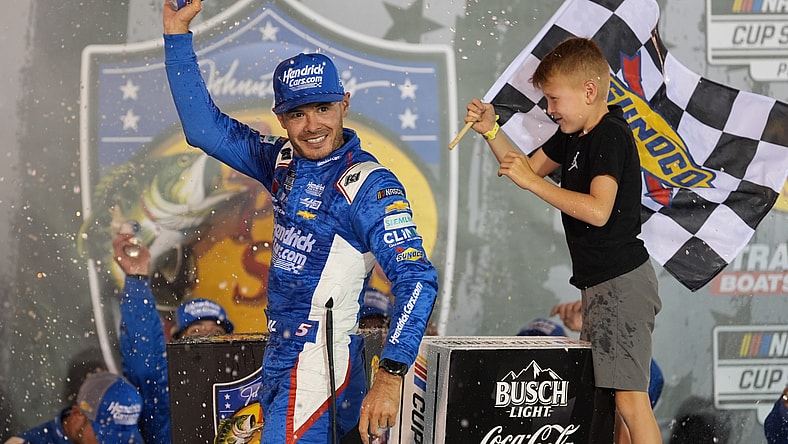
Kyle Larson and the Hendrick Motorsports No. 5 team executed a beatdown at Bristol Motor Speedway that hasn’t been seen in nearly half a century.
They led 462 of 500 laps in the Bristol Night Race, the most led by a winner since Cale Yarbrough’s 496 in April 1977, and the 7.088 second margin of victory was the greatest in the nearly three-year history of the NextGen car.
Holistically, it was a reminder that the path to the NASCAR Cup Series championship still runs through them.
Meanwhile, the dream of a second championship is over for two Hall of Famers in Brad Keselowski and Martin Truex, who were eliminated alongside Ty Gibbs and Harrison Burton.
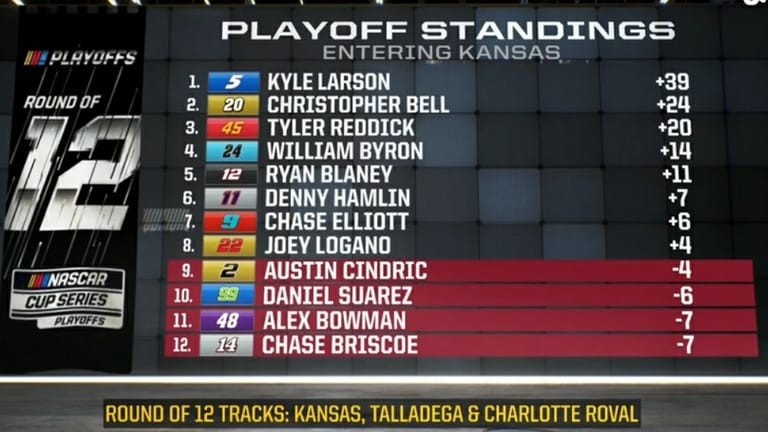
Which means, the much-ballyhooed Denny Hamlin slump saga survived this first round, the winningest driver without a championship advancing to the Round of 12 alongside Larson, Joey Logano, Christopher Bell, Tyler Reddick, William Byron, Ryan Blaney, Denny Hamlin, Chase Elliott, Austin Cindric, Daniel Suarez, Alex Bowman and Chase Briscoe.
As one might expect from a race that was so dominated by one driver, the rest of the race was largely procedural as well, producing just three naturally occurring cautions, and a grind for anyone to complete passes.
Even Larson, as mighty as his car was on Saturday, struggled to get past cars that were two or three laps down.
It was a slog.
Momentum
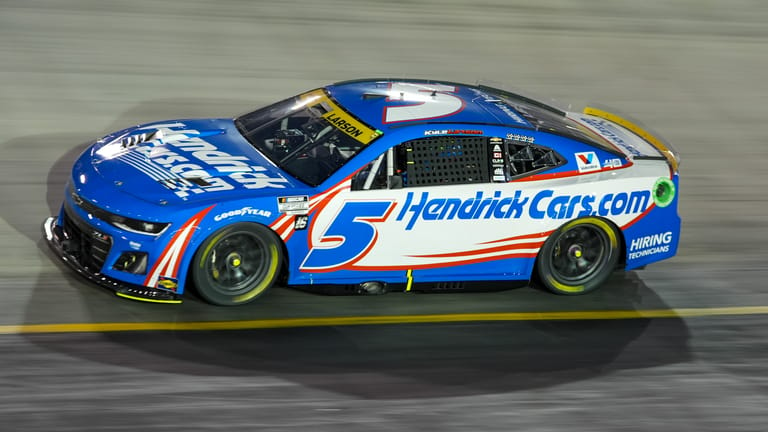
The Hendrick No. 5 was so good, so dominant, that Daniels only had to make one adjustment after the second run to give his driver just a little more grip.
“Thankfully, Cliff and them, I don’t think they made any adjustment after that,” Larson said.
This is one of the greatest cars that Hendrick Motorsports has given him and he delivered a win with it.
And it’s hard to believe, but Larson was in a bit of a slump over the past month, not so much in terms of performance, but circumstances, and how they influence results but there were three finishes outside the top-20 over the past five races.
The playoffs began with a crash at Atlanta and an equipment violation penalty, but they had so many playoff points that only a catastrophic result on Saturday would have led to an elimination. But it was still important to take this kind of momentum to begin the second round, not to mention seven more playoff points.
“Yeah, I definitely think it was important, and the way we see it is when each round resets, you really have to make sure you’re batting with what everybody else is or scoring close to par, however you want to say it,” Daniels said.
“There was a lot of stage points that we missed out on the last two weeks, of course, and race wins, just with some issues that we created for ourselves. Obviously Atlanta was kind of a fluke thing coming to the end of a stage where we could have gotten some decent stage points there.
“We had it on our radar if we could perform and execute the way we needed to, at least get a stage win or two here or there, and you never know if you’re going to get a win, but it was important for us to try to finish the round really strong and handle what we could on our own to leave less to chance the way it was going to come down to points and everything by the end of today.”
Legends eliminated
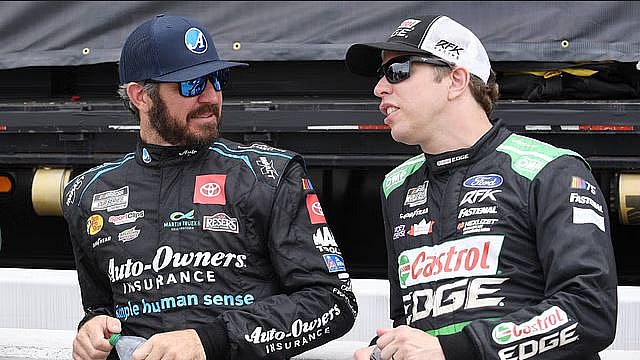
Brad Keselowski and Martin Truex Jr. are the 2012 and 2017 Cup Series champions respectively, and future Hall of Famers, but they ultimately didn’t have the speed needed to make a deep playoff run.
Really, Truex entered this playoff as the winless lowest seeded contender, the 10th-place driver on points but just never fully broke through. They had just two top-10s in the past 17 races. Granted, some of that was a byproduct of circumstances too but they suffered a lot of self-inflicted wounds.
Truex finished fourth and second in the first two stages, and then more of the same happened, speeding on pit entry by .9 over the tolerance.
“It was .09 mph, just really frustrated and upset,” Truex said. “We had to run second or third to make it, not sure if we would have but it would’ve been nice to see, I just hate I screwed it up for everybody.”
Truex, who is retiring at the end of the season and will not chase a championship during that span, said this summer was just an exercise in swallowing disappointment after disappointment.
So what now without a championship to chase?
“Just go race hard, it’s been a tough three races to start the playoffs, showed a lot of promise tonight but had pit road issues, that’s on me.”
Gibbs suffered a similar mistake, a pit road speeding penalty, and he just wasn’t able to climb back through the field with a car that finished eighth in the first stage, and had built on the six point advantage he had entering the night.
The word of the night was unfortunate.
“That was just unfortunate there,” Gibbs said. “I felt like we were really good in practice and qualifying. Just a little too loose tonight and fired off too tight. Unfortunate. Speeding penalty is on me. You run the lights so close – it’s my fault. Unfortunate. I’m proud of the He Gets Us Toyota guys and all of the effort they put in.”
Keselowski lost a lap early and never could recover. He simply wasn’t fast enough.
“Just a long night,” Keselowski said. “Just didn’t have any pace. No attrition for the race, tires didn’t fall off and we didn’t have the pace.”
Keselowski had finishes of 19th, 26th and 26th this round and none of that was really fluky either.
“We didn’t show up in this round, I guess is probably just the easiest way to put it,” Keselowski said. “We didn’t get any results and it’s a results business.”
Harrison Burton, who won a crash-filled Daytona race to leap from 34th in the championship into the top-16, was a non-factor throughout the first round and was eliminated early due to a power steering issue during the middle portions of the race.
Overcoming adversity

Lulu is safe.
Denny Hamlin, jokingly but not really, had become increasingly convinced that adopting a puppy in June at Gateway was derailing his season. He went from winning three times with an 11th place average finish and no DNFs to no wins, a 20th place average finish, three DNFs and a crippling NASCAR engine seal penalty.
He crashed at Atlanta, crashed at Watkins Glen and entered this cutoff race six points below the cutline. He made that deficit up by the end of the second stage and increased that advantage with a fourth place.
Hamlin is onto the second round and Lulu doesn’t need to be re-homed, but he was absolutely waiting for something bad to happen.
“Yes,” Hamlin said. “I even told (spotter Chris Lambert) I didn’t want a count down. I’ve had some unfortunate things happen so I was definitely hoping it would stay green. I wanted it to finish out naturally and luckily everyone kept their heads on straight.”
So what’s the ceiling for this team now?
“I want to get back on track of contending for wins every week and now we’re going to Kansas where I feel really confident. I feel like this is a reset, where I can put away the past, and go on offense.”
Chase Briscoe is driving for a team, Stewart-Haas Racing, that will shut down at the end of the season, has been cut off from Ford Performance resources, does not get the same simulator time as their peers at Team Penske, and yet, just advanced to the Round of 12.
Even more impressive is that he crashed out of the race at Atlanta, faced a 20-point deficit, made it all up at Watkins Glen by scoring the most points and then ran around the top-5 all night at Bristol. They could have even contended for a podium if not for a series of subpar pit stops.
Oh, and Briscoe went all race without a rear view camera.
“It’s tough just with this car, you get so used to it where you can just look at it, you can clear yourself,” Briscoe said. “Of all the tracks, this is one of the hardest ones to not have it, just with how you turn down on exit. Guys have always been tight.
“I was probably more worried about that than anything just when it happened. But after I got used to it for 100 or so laps, it kind of became natural.”
There was even a brake fan fire.
“It definitely seemed like everything that could go wrong kind of went wrong,” Briscoe said. “When the thing started smoking, I thought our day was done. I turned the brake fans on, and I think it started a fire in the front.
“Fortunately, it went out as soon as I turned the fans off, but that could have been disastrous.”
So how did it feel to advance after all that?
“I feel like I just got two tetanus shots in my arm but other than that I feel good.”
Throughout this entire run, the entirety of Stewart-Haas Racing has rallied around Briscoe and the 14 team, placing their entire hopes and energy into sending off their company as champions.
“We have good people,” Briscoe said. “People who are hungry and have an edge right now because our backs are up against the wall. I don’t know how to word this … Its not that we want to stick it to SHR, but we want to prove that we can do this and know what we are capable of.
“I don’t know what it is but there’s this confidence and swagger amongst the entire building and it’s unlike anything I have experienced since I was a Cup driver. The only thing I can compare it to is being an Xfinity driver at SHR at the time Kevin (Harvick) and the No. 4 guys were winning nearly 10 races and how that energized the entire building.”
Race quality conversation
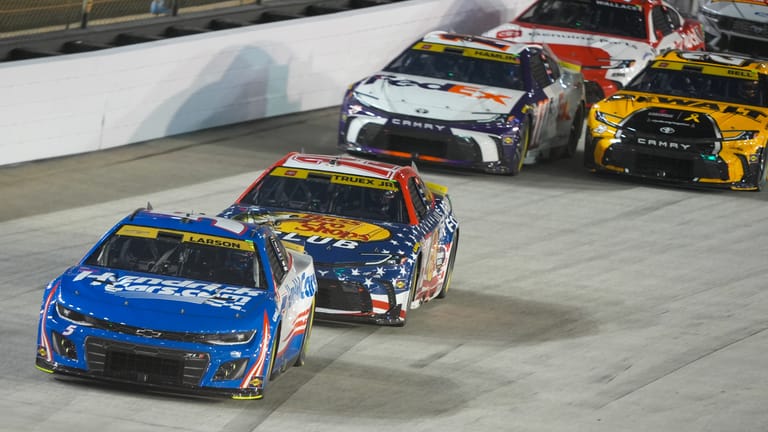
There are so many race quality questions after the Bristol Night Race.
Why was Goodyear unable to replicate the extreme tire wear from the spring race despite having the same tire compound from that day plus a formula that shredded during a summer test in the heat of day in July?
Beyond that, why was the race largely so procedural, with minimal speed disparity and largely minimal attrition … highlighted by a winner who led 92 percent of the proceedings.
Those were all talking points afterwards.
As articulated by several crew chiefs earlier in the day, there is still a conviction that the tires were just fundamentally different in March in ways that no one quite understands.
First, these nuggets from 23XI No. 23 engineer JR Houston:
Gabehart says this all stems from a spec car that has less power and more grip than any that preceded it.
“It’s too easy to drive,” said the former Super Late Model champion turned crew chief. “They’re too close, and you’re not going to ask for much better racing. I’m sorry you’re not.
“The bottom was good. The middle was good. The top was good. But they’re all separated by 0.0-nothing. And physics is a buffer.
“You know, these are the world’s best Stock Car teams and drivers. If you don’t give them enough ways to separate themselves, this is what you’re going to see. So, I actually thought it was as good a race as you could hope for.
“Now I was, I was busy, so maybe that’s not a great objective opinion, maybe. Maybe I’d go back and watch it and get a different take. But the days of the old Bristol are over with this car. That’s just the truth.”
His driver, Hamlin, echoed that point too.
“Running close to the same car, it’s on a short track and the tire doesn’t fall off, right,” Hamlin said. “It either doesn’t last 40 laps or it lass 200. We’ve got to get some consistency in the tires going but other than that, all these cars are equal, the drivers are equal and that’s why it’s so hard to pass.”
Daniels, who granted is biased because he won, agreed with Gabehart that this is as good of a race on this kind of tire that Bristol can produce … and Goodyear will be hard pressed to reproduce what happened in March.
“Yeah, I think it would be very hard to recreate the spring again because of the element of surprise,” Daniels said. “I do think it’s a real thing at the concrete tracks. A lot of folks may not remember, there was a practice at Dover a year or two ago where it was a really cool day, and the race tire at Dover that weekend really looked like what the Bristol tire looked like in the spring.
“It was really powdery, dusty, to the cords right away, and that race weekend in Dover the sun came out on Sunday and the track took rubber and kind of fixed everything.
“I think a lot of that is what’s at play here. Everyone is certainly going to have their opinion on what you want to see, but I just find it hard to think that we could sustain or recreate the environment of what happened in the spring.
“From my seat, yes, we led a lot of laps today, but there was a lot of good, hard racing today. A lot of side-by-side battles. You had multiple lanes working. I don’t know, that makes for a really good race in my opinion, from a racer’s standpoint. I’m okay with the way it was today. Less chaos.”